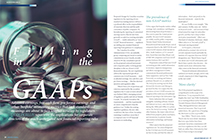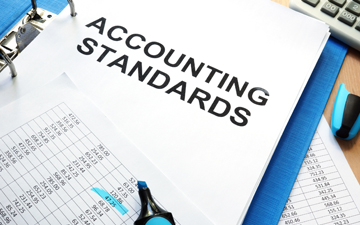Fill in the non-GAAP: New disclosure requirements to become mandatory in August 2021

Marie-Christine Valois and Janie Harbec of Fasken review the new National Instrument 52-112, Non-GAAP and Other Financial Measures Disclosure
MONTREAL – Lack of transparency in calculations, insufficient context and significant variations by issuer and industry, a "stronger tool was needed to take appropriate regulatory action", said the Canadian Securities Administrators (CSA) when they first presented their new set of rules to regulate disclosure of non-GAAP financial metrics. That was in 2018.
Many comment letters and three versions later, we now have the final version of the National Instrument 52-112 Non-GAAP and Other Financial Measures Disclosure (the Instrument).
Unlike the existing guidance on non-GAAP financial measures (Staff Notice 52-306), the new Instrument has the force of law. This means that the "adjusted earnings", "adjusted EBITDA", "free cash flow", "pro forma earnings" and other financial measures of this world will soon be the target of much scrutiny, because the new Instrument, while short, is accompanied by a 20-pages long Companion Policy, which clearly spells out the intention of the legislators.
1. Who falls in the Non-GAAP
The Instrument applies to all reporting issuers, except investment funds and certain foreign issuers, and to non-reporting issuers for certain offering documents and transactions.
Reporting issuers will be subject to the new rules when they disclose financial measures outside their financial statements, including disclosures on websites, in news releases, and in social media platforms. As for non-reporting issuers, the Instrument will only apply with respect to an offering memorandum or related marketing materials if the document is filed in connection with a distribution made pursuant to an offering memorandum exemption. It will also apply to non-reporting issuers in other specific scenarios, such as in the case of an IPO, a reverse takeover, a significant acquisition or similar transactions.
However, it is important to note that the Instrument also contains a few exceptions, notably for issuers in the mining and oil and gas industries. The Instrument does not apply (1) to the disclosure required with respect to an issuer's material mineral project pursuant to National Instrument 43-101 Standards of Disclosure for Mineral Projects and under section 5.4 of Form 51-102F2 Annual Information Form (Description of the Business for Companies with Mineral Projects), and (2) to disclosure required under National Instrument 51-101 Standards of Disclosure for Oil and Gas Activities, with the exception of disclosures of oil and gas metrics that are made under section 5.14 of that Instrument (Disclosure Using Oil and Gas Metrics) as an issuer includes them on a voluntary basis.
2. When to fall in the Non-GAAP?
The Instrument will become effective on August 25, 2021 and will apply to disclosures for a financial year ending on or after October 15, 2021 for reporting issuers, and for filings after December 31, 2021 for non-reporting issuers.
3. How will this change the Non-GAAP Landscape?
No doubt, the Instrument and its Companion Policy will change the non-GAAP disclosure landscape. Here are a few examples of how the relevant issuers and their disclosure will be impacted:
A. Mind the Non-GAAP Definitions
The Instrument applies to five different concepts, each having their own definition: (1) non-GAAP financial measures, (2) non-GAAP ratios, (3) total of segments measure, (4) capital management measure, and (5) supplementary financial measure. Therefore, it is not because a figure does not fall into the definition of a non-GAAP financial measure that it is not going to be considered as a non-GAAP ratio or a supplementary financial measure, for example. Disclosure requirements are determined based on which definition the figure meets.
The Companion Policy gives the example of an issuer that discloses sales per ft2 on a periodic basis, which figure is extracted directly from the issuers' financial statements or is a component of such line item:
- If the sales figure is calculated in accordance with the issuer's accounting policies used to prepare the line item, it meets the definition of supplementary financial measure.
- However, if the sales figure is not calculated in accordance with the issuer's accounting policies, it meets the definition of non-GAAP ratio.
The disclosure required for non-GAAP ratios is more extensive than for supplementary financial measures. For example, when disclosing non-GAAP ratios, the issuer shall disclose, an explanation of (1) the composition of the non-GAAP ratio, (2) how the non-GAAP ratio provides useful information to an investor and the additional purposes, if any, for which management uses the non-GAAP ratio, and (3) the reason for any change in the label or the composition of the non-GAAP ratio. Such disclosure is not required with respect to supplementary financial measures, but some lighter disclose is still required.
B. Exec Comp Falls into the Non-GAAP Requirements
During the consultation period, opinions were mixed as to whether the measures used for executive compensation should be explicitly included in the Instrument, but when assessing comments on this topic, the CSA did not see the policy rationale to treat such measures differently.
However, just like for the other measures, the Instrument's requirements are only triggered by the disclosure of a financial numerical amount for the measure, not by qualitative disclosure. Similarly, in the context of a Statement of Executive Compensation, if a financial measure is identified (e.g., adjusted net income) and the calculation is described (e.g., net income adjusted for foreign exchange gains or losses) but no financial amount is disclosed (i.e., no dollar amount), the new rules would not apply because a financial measure has not been disclosed, it was only identified and described.
C. Non-GAAP Reconciliation
The requirement to provide a quantitative reconciliation between the non-GAAP financial measure and the most directly comparable financial measure presented in the issuer's financial statements is nothing new. What's new, however, is the 2-pages long explanation provided in the Companion Policy about this specific item. The Companion Policy explains, among other things, how to: (1) identify the most directly comparable financial measure, (2) determine the prominence and the proximity of a non-GAAP financial measure, (3) calculate the reconciliation using entity-specific inputs, (4) determine the level of detail expected in the reconciliation, and (5) present and format the information required. By providing such level of detail, the CSA definitely offer more clarity as to their expectations.
The Companion Policy also contains extensive guidance on a number of other sections of the Instrument, including on how to label a financial measure, how to assess and explain the usefulness of a financial measure, how to present comparative information for a non-GAAP financial measure or a non-GAAP ratio, to name only a few. It also contains a list of measures that are not captured by the Instrument, for example, amounts that do not depict historical or future "financial performance", "financial position" or "cash flow", which relate to elements of the issuer's financial statements, such as share price, market capitalization, or credit rating.
D. The Non-GAAP Flexibility
The Instrument is intended not to contain specific limitations or industry-specific requirements on how to calculate a measure; the CSA believes that non-GAAP financial measures or other financial measures are set in time and are constantly evolving across a wide range of industries. The objective of the Instrument was to respond to the investors' need for quality financial information and, according to the CSA, an overly prescriptive framework could prevent that.
As part of the feedback received from various participants during the consultation period, flexibility was recognized as a major factor to ensure that the Instrument is viable in the long term and as such, the final version reduces the scope of its application to certain issuers, exempts certain disclosures and allows an issuer to incorporate by reference certain disclosure in an MD&A or a news release.
E. Dollar Figure on Non-GAAP Requirements?
When the CSA first introduced the Instrument in 2018, they stated that no increase in costs was expected for the issuers to comply with the new disclosure requirements mainly because the Instrument had substantially incorporated the disclosure guidance that was already required pursuant to Staff Notice 52-306. However, the CSA conceded that the introduction of new concepts, such as segment measures, capital management measures, and supplementary financial measures, together with associated disclosure requirements, could result in additional administrative costs for the issuers, at least in the first reporting period if such measures were to be disclosed. The CSA qualified such costs of "immaterial" at the time. It remains to be seen, now that the Instrument is in its final version, how much time and money the issuers will need to spend to understand and conform to the new 30-pages long rules and guidance.
Furthermore, even though the Instrument states that the required disclosure of comparative information for non-GAAP figures can be omitted if it is "impracticable" to do so, the cost or the time involved in preparing such disclosure would not be sufficient rationale for an issuer to avoid providing such disclosure.
4. Is the Non-GAAP closed?
The Instrument is final but it is not immune to additional amendments due to the potential changes to International Financial Reporting Standards (IFRS). The International Accounting Standards Board (IASB) has published in January 2021 proposals for changes to IFRS to give investors better information about issuers' financial performance. These changes could, among other things, change the structure and content of the income statement and result in some non-GAAP measures being included in a note to the financial statements and could thus require new mandatory disclosure. As the IASB proposals are at an early stage, it is difficult to determine what changes, if any, will be made to IFRS. The CSA mentioned monitoring those IASB proposals and will consider at that time if changes to IFRS will also mean further changes to securities legislation, including the Instrument.
Marie-Christine Valois and Janie Harbec are associates in the Montreal office of Fasken Martineau DuMoulin LLP ("Fasken").










(0) Comments